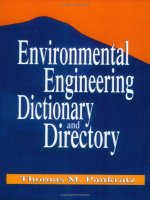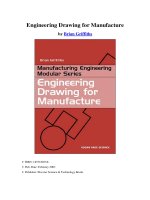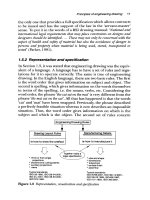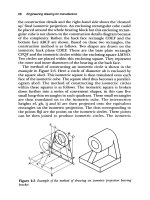Engineering Drawing CAD Standards
Bạn đang xem bản rút gọn của tài liệu. Xem và tải ngay bản đầy đủ của tài liệu tại đây (773.05 KB, 24 trang )
MORAINE VALLEY COMMUNITY COLLEGE
Engineering Drawing
& CAD Standards
Mechanical Design/CAD Program
C. Bales, M. Vlamakis
Revision:May 11, 2010
9000 WEST COLLEGE PARKWAY, PALOS HILLS, ILLINOIS, 60465
Engineering Drawing & CAD Standards
2010
TABLE OF CONTENTS
I.
Line Conventions................................................................................................................................................ I-4
Center lines ............................................................................................................................................................. I-4
II.
Drawing Conventions ........................................................................................................................................ II-8
Auxiliary Views ....................................................................................................................................................... II-8
Partial Views .......................................................................................................................................................... II-8
Section Views ......................................................................................................................................................... II-8
Conventional Breaks .............................................................................................................................................. II-9
Developments ...................................................................................................................................................... II-10
III.
Dimension Conventions ................................................................................................................................. III-10
Dimension Appearance....................................................................................................................................... III-10
Dimensioning Procedure .................................................................................................................................... III-13
Dimension Notes ................................................................................................................................................ III-13
Preferred Sizes .................................................................................................................................................... III-16
IV.
Thread and Fastener Representation ............................................................................................................ IV-17
V.
Tables .............................................................................................................................................................. V-22
Bill of materials .................................................................................................................................................... V-22
Revision tables ..................................................................................................................................................... V-22
VI.
Drawing media ............................................................................................................................................... VI-23
9000 West College Parkway, Palos Hills, Illinois, 60465
Page I-2
Engineering Drawing & CAD Standards
2010
The information contained in this departmental standard supersedes the ASME standards listed below:
ANSI/ASME Y14.2M-1992 (R2003)
Line Conventions and Lettering
ANSI/ASME Y14.3-2003
Multi and Sectional View Drawing
ANSI/ASME Y14.34M-1996
Parts Lists, Data Lists, and Index Lists
ANSI/ASME Y14.36M-1996 (R2002)
Surface Texture Symbols – Metric Version
ANSI/ASME Y14.35M-1997 (R2003)
Revision of Engineering Drawing and Associated Documents
ANSI/ASME Y14.38-1999
Abbreviations and Acronyms
ANSI/ASME Y14.5-2009
Dimensioning and Tolerancing
ANSI/ASME Y14.6-2001 (R2007)
Screw Thread Representation, Engineering Drawing, and Related
Documentation Practice
ANSI/ASME Y14.6AM-2001 (R2007)
Screw Thread Representations (Metric Supplement)
9000 West College Parkway, Palos Hills, Illinois, 60465
Page I-3
Engineering Drawing & CAD Standards
I.
2010
LINE CONVENTIONS
A. The lines shown in Figure 1.1 are to be used in all mechanical drawings. The corresponding AutoCAD
linetype and lineweight are given next to each linetype.
FIGURE 1.1: STANDARD LINESTYPES AND LINEWEIGHTS.
B.
The AutoCAD linetype scale (LTSCALE) for mechanical drawings plotted at a scale of 1:1 shall be set
according to the table shown below:
System of Measurement
Decimal-inch
Metric
C.
LTSCALE
0.5
12
Drawing scale
1:1
1:1
The linetype scale shall be modified proportionally for drawings plotted at scales other than 1:1. For
example, if the drawing scale is 1:2 for a metric drawing, the LTSCALE shall be set to 6 (=12 x ½).
CENTER LINES
D. The center mark size dimension variable in AutoCAD shall be .09” (2 mm).
E.
The center mark shall extend .09” (2 mm) beyond the edges of circular features (see Figure 1.2).
9000 West College Parkway, Palos Hills, Illinois, 60465
Page I-4
Engineering Drawing & CAD Standards
F.
2010
A center line representing the longitudinal axis of a cylindrical or rectangular feature shall extend
.312” (8 mm) beyond the boundary of the feature (see Figure 1.2).
FIGURE 1.2: CENTERLINE EXTENSIONS.
G. A center line shall not be lengthened to create the small dash when the center line is too short to
show a single small dash.
H. When a center line and visible or hidden line are coincident, the center line shall end before the
visible line or hidden line and there shall be a .09” (2 mm) gap between the end of the center line and
the beginning of the visible line (see Fig. 1.3 and 1.4).
FIGURE 1.3: CENTERLINES COINCIDENT WITH VISIBLE LINES.
9000 West College Parkway, Palos Hills, Illinois, 60465
Page I-5
Engineering Drawing & CAD Standards
I.
2010
If center lines are required for features arranged in a radial pattern, the center lines shall be oriented
radially but shall not intersect at the center of the pattern (see Figure 1.4). Note that the centerline
bolt circle may not have the small dashes oriented at the centers of the pattern of features.
FIGURE 1.4: CENTERLINES IN RADIAL PATTERNS.
J.
Center lines of features arranged in a rectangular pattern shall be extended so that the pattern is
continuous (see Figure 1.5). Note that the center marks for the rounded corners are extended .09” (2
mm) beyond the edge of the part.
FIGURE 1.5: CENTERLINES IN RECTANGULAR PATTERN.
9000 West College Parkway, Palos Hills, Illinois, 60465
Page I-6
Engineering Drawing & CAD Standards
K.
2010
Where center marks are used in semi-circular features, the center mark shall only extend through the
circular feature edge (see Figure 1.6).
FIGURE 1.6: CENTER MARKS THROUGH SEMI-CIRCULAR FEATURES.
L.
Center lines may be used to indicate planes of symmetry. In such cases, the center lines shall extend
.312” (8 mm) beyond the edges of the symmetrical feature (see Figure 1.7). Center lines used as lines
of symmetry do not require symmetry marks.
FIGURE 1.7: CENTERLINES FOR SYMMETRICAL FEATURES.
9000 West College Parkway, Palos Hills, Illinois, 60465
Page I-7
Engineering Drawing & CAD Standards
II.
2010
DRAWING CONVENTIONS
AUXILIARY VIEWS
A. Auxiliary views shall be connected to the adjacent view from which they are developed by a single
center line or an extension line connecting identical external edges of the part. The centerline shall
go through the same feature in both views. The extension line shall have a gap between the visible
edge of the part and the extension line equal to .09” (2 mm) (see Figure 2.1).
FIGURE 2.1: AUXILIARY VIEWS.
B.
The break line on all partial auxiliary views shall be smooth curve (see Figure 2.1).
C.
Hidden lines shall be omitted on features when they appear foreshortened in orthographic views.
PARTIAL VIEWS
D. The break line on all partial views shall be created with a smooth curve (see Fig. 2.1).
SECTION VIEWS
E.
The break line on all broken-out section views shall be created with a smooth curve (See Fig. 1.1).
F.
The plotted arrowhead size on the cutting-plane line shall be .25” (6 mm), two times (2x) the size of
the dimension arrow.
G. Cutting-plane lines shall be drawn with thick phantom lines (lineweight = 0.6 mm) (See Fig. 1.1).
9000 West College Parkway, Palos Hills, Illinois, 60465
Page II-8
Engineering Drawing & CAD Standards
2010
H. When a cutting-plane line is coincident with a visible, hidden, or center line, the cutting-plane line
shall take precedence.
I.
The cutting-plane line shall extend .50” (12 mm) from the edge of the object and extend at right
angles .50” (12 mm) from the extension (see Fig. 2.2).
FIGURE 2.2: CUTTING PLANE LINES.
CONVENTIONAL BREAKS
J.
Solid cylinders may be broken into shorter segments in a drawing. When the solid cylinder is broken,
the ends shall be shown with a conventional shaft break. The dimensions for drawing the shaft break
are shown in Fig. 2.3.
FIGURE 2.3: SHAFT BREAK CONSTRUCTION.
J.
The dimension for the overall length of the broken cylinder shall be underlined to clearly indicate that
it is not drawn to scale.
9000 West College Parkway, Palos Hills, Illinois, 60465
Page II-9
Engineering Drawing & CAD Standards
2010
DEVELOPMENTS
J.
Developed views shall show quadrants with thin solid lines.
K.
Sheet metal developments shall show the center line of the bends with centerlines which extend
beyond the edges of the object .312” (8 mm).
III.
DIMENSION CONVENTIONS
DIMENSION APPEARANCE
A. There shall be no gap between extension lines and center lines.
B.
Drawings in decimal-inch units shall use the ROMANS AutoCAD font for all drawing text. Metric
drawings shall use the ISOCP AutoCAD font.
C.
The plotted size of text (including dimensions) shall be .125” (3 mm). All tolerances shall be drawn at
full text height.
D. All drawing text shall have a thin lineweight (lineweight = 0.3 mm).
E.
Dimensions and drawing notes shall specify decimal numbers and not fractions. All fractions shall be
converted to decimals with the appropriate decimal places according to the tolerance specifications.
F.
If an extension line crosses an arrowhead the extension line shall be broken around the arrowhead.
G. When more than one diameter is dimensioned in a single note always point to the outside (larger)
circle.
H. A leader line shall end with the same style and size arrowhead as used with dimension lines. The
leader line shall be oriented close to 45°, but between 30° and 60°, and not horizontal or vertical.
I.
When inch dimensions are shown in a millimeter drawing the abbreviation “IN” shall follow the inch
value. When millimeter dimensions are shown in an inch drawing the abbreviation “mm” shall follow
the millimeter value.
J.
When dimensioning with dual dimensions, square brackets shall be used around the second unit
value.
9000 West College Parkway, Palos Hills, Illinois, 60465
Page III-10
Engineering Drawing & CAD Standards
K.
2010
When a dimension needs to locate an intersection or bend, extension lines are drawn in the profile
view as shown in Fig. 2.3. The extended intersection lines are drawn on a thin layer. The lines shall
be offset from the object lines by .09” (2 mm) and cross by .09” (2 mm).
FIGURE 3.1: EXTENDED INTERSECTIONS.
L.
Symbols are preferred over the corresponding complete word or abbreviation in dimensions and
drawing notes. The symbols are shown in Figure 3.2. Dimensions for symbols shown are as plotted.
The dimension variable, h, represents the plotted dimension text height. For decimal-inch drawings
h=.125”, and for metric drawings h=3 mm.
M. Symbols shall be selected from the GDT font in AutoCAD. If the standard symbol shown in Fig. 3.2
does not exist in the GDT font, then it shall be created according to the dimensions given in Fig. 3.2.
N. Where no symbol exists, standard abbreviations are preferred over complete words.
9000 West College Parkway, Palos Hills, Illinois, 60465
Page III-11
Engineering Drawing & CAD Standards
2010
Figure 3.2: DIMENSION SYMBOLS.
9000 West College Parkway, Palos Hills, Illinois, 60465
Page III-12
Engineering Drawing & CAD Standards
2010
O. A surface texture symbol with text or numbers shall be oriented horizontally. Surface texture
symbols without text or numbers shall be oriented at any angle. Surface texture symbols shall be
placed on the outside of the part geometry.
DIMENSIONING PROCEDURE
P.
All drawing text shall be placed in Paper Space.
Q. To convert from inches to millimeters multiply the inch value by 25.4 to find the corresponding value
in millimeters. To convert from millimeters to inches multiply the inch value by .03937 to find the
corresponding value in inches.
R.
Conversion from fractional-inch to decimal-inch units shall take into account the full number of
decimal places. The number of decimal places shown in the dimension shall be truncated according
to the required tolerance level.
Example:
Original dimension: 3-1/64”
Convert to decimal format: 3.015625”
Dimension tolerance: ±.001
Converted dimension: 3.015±.001
DIMENSION NOTES
S.
Drawing text shall be displayed in all capital letters.
T.
All drawing notes shall be placed on the NOTES layer.
U. General drawing notes shall be placed to the left of the title block.
V. The format for general notes shall be as shown below. The number for each line shall be aligned
under the heading.
NOTES:
1. FIRST NOTE
2. SECOND NOTE
3. THIRD NOTE
P.
The following are drawing notes which shall be shown on all mechanical drawings:
DRAWING IN ACCORDANCE WITH ASME Y14.5-2009.
ALL DIMENSIONS IN INCHES (or MILLIMETERS).
9000 West College Parkway, Palos Hills, Illinois, 60465
Page III-13
Engineering Drawing & CAD Standards
2010
Q. The following are examples of drawing notes which are to be included in the drawing according to
need. Notes must be modified according to the specification of the drawing.
ALL FILLETS AND ROUNDS R(x) UNLESS OTHERWISE SPECIFIED.
REMOVE ALL BURRS AND SHARP EDGES.
FINISH ALL OVER.
CHAMFER BOTH ENDS (x) X (x)°
ALL DIMENSIONS BASIC UNLESS OTHERWISE SPECIFIED.
ALL UNTOLERANCED DIMENSIONS ±(x)
ALL THREADS IN ACCORDANCE WITH ASME B1.13M-2001. (for Metric M profile threads only).
ALL THREADS IN ACCORDANCE WITH ASME B1.1-2003. (for Unified inch screw threads only).
SURFACE TEXTURE IN ACCORDANCE WITH ASME Y14.36-1996 (R2002).
SURFACE TEXTURE UNITS IN µM (or µIN).
ALL SURFACES TO BE
SURFACES MARKED
needed).
UNLESS OTHERWISE SPECIFIED. (modify roughness value as needed)
TO BE
UNLESS OTHERWISE SPECIFIED. (modify roughness value as
9000 West College Parkway, Palos Hills, Illinois, 60465
Page III-14
Engineering Drawing & CAD Standards
2010
W. Common standard abbreviations are shown in the following table.
Assembly
Auxiliary
Backface
Bearing
Between centers
Bolt circle
Both faces
Both sides
Brass
Bronze
Cap screw
Cast iron
Cast steel
Casting
Center
Center line
Center to center
Chamfer
Circular
Clearance
Clockwise
Counterbore
Countersink
Counterclockwise
Decimal
Deep/Depth
Dimension
Distance
Double
Equal
Equally spaced
Fastener
Fillet
ASSY
AUX
BF
BRG
BC
BC
BF
BS
BRS
BRZ
CAP SCR
CI
CS
CSTG
CTR
CL
C TO C
CHAM
CIR
CL
CW
CBORE
CSK
CCW
DEC
DP
DIM
DIST
DBL
EQL
EQLSP
FSTNR
FIL
Fillister
Finish all over
Flat head
Flat point
Gage
Head
Headless
Hexagonal
Inch
Inside diameter
Keyseat
Keyway
Left hand
Length
Lockwasher
Long
Machine screw
Malleable iron
Material
Maximum
Micrometer
Millimeter
Minimum
Multiple
Number
On center
Outside diameter
Outside face
Overall
Part
Perpendicular
Pitch
FIL
FAO
FLH
FP
GA
HD
HDLS
HEX
IN
ID
KST
KWY
LH
LG
LKWASH
LG
MSCR
MI
MATL
MAX
µm
mm
MIN
MULT
NO
OC
OD
OF
OA
PT
PERP
P
Pitch circle
Pitch diameter
Point
Pratt & Whitney
Quadrant
Quarter
Radial
Radius
Rectangle
Reference line
Relief
Required
Right hand
Root mean square
Round
Screw
Section
Set screw
Sheet
Single
Slotted
Socket
Socket head
Square
Standard
Steel
Surface
Thick
Thread
Through
Washer
Woodruff
Worm gear
PC
PD
PT
PW
QDRNT
QTR
RDL
R
RECT
REFL
RLF
REQD
RH
RMS
RND
SCR
SECT
SSCR
SH
SGL
SLTD
SKT
SCH
SQ
STD
STL
SURF
THK
THD
THRU
WSHR
WDF
WMGR
9000 West College Parkway, Palos Hills, Illinois, 60465
Page III-15
Engineering Drawing & CAD Standards
2010
PREFERRED SIZES
K.
The preferred basic sizes for computing tolerances in metric units are given in table below. All sizes
are in millimeters.
First
Choice
1
Second
Choice
First
Choice
10
1.1
1.2
Second
Choice
12
1.8
120
20
2.8
200
28
3.5
40
5.5
400
60
550
600
70
80
9
450
500
55
7
8
350
45
50
6
280
300
35
4.5
5
220
250
30
4
180
22
25
3
140
160
18
2.2
2.5
110
14
16
2
Second
Choice
11
1.4
1.6
First
Choice
100
700
800
90
900
1000
L.
The preferred basic sizes for computing tolerances in decimal-inch units are given in two tables
below. When specifying fits, the basic size of mating parts shall be chosen from the decimal series or
the fractional series.
.010
.012
.016
.020
.025
.032
.040
.05
.06
.08
.10
.12
.16
.20
.24
.30
.40
.50
.60
.80
1.00
1.20
1.40
1.60
1.80
Decimal Series (in.)
2.00
4.60
2.20
4.80
2.60
5.00
2.80
5.20
3.00
5.40
3.20
5.60
3.40
5.80
3.60
6.00
3.80
6.50
4.00
7.00
4.20
7.50
4.40
8.00
8.50
9.00
9.50
10.00
10.50
11.00
11.50
12.00
12.50
13.00
13.50
14.00
14.50
15.00
15.50
16.00
16.50
17.00
17.50
18.00
18.50
19.00
19.50
20.00
9000 West College Parkway, Palos Hills, Illinois, 60465
Page III-16
Engineering Drawing & CAD Standards
.015625
.03125
.0625
.09375
.1250
.15625
.1875
.2500
.3125
.3750
.4375
IV.
2010
.5000
.5625
.6250
.6875
.7500
.8750
1.0000
1.2500
1.5000
1.7500
2.0000
Fractional Series (in.)
2.2500 5.0000
9.5000
2.5000 5.2500
10.0000
2.7500 5.5000
10.5000
3.0000 5.7500
11.0000
3.2500 6.0000
11.5000
3.5000 6.5000
12.0000
3.7500 7.0000
12.5000
4.0000 7.5000
13.0000
4.2500 8.0000
13.5000
4.5000 8.5000
14.0000
4.7500 9.0000
14.5000
15.0000
15.5000
16.0000
16.5000
17.0000
17.5000
18.0000
18.5000
19.0000
19.5000
20.0000
THREAD AND FASTENER REPRESENTATION
A.
The arrowhead from the leader of a thread note shall be attached to the outer (hidden line)
circle of a tapped (threaded) hole (see Figure 4.1).
FIGURE 4.1: THREAD NOTATION LEADER.
B.
Decimal values shall be used in all thread notation. Fractional values shall be converted decimals
with the appropriate number of decimal places based on tolerance requirements.
C.
Drill numbers shall not be specified in the thread notation. The drill number shall be converted
to the corresponding decimal size.
D.
Unless specified otherwise, threads shall be drawn with the simplified representation.
E.
Threads drawn with the schematic representation shall show the crest and root lines with a thin
lineweight, as shown in Fig. 4.2. The end of the threads shall be drawn with a thick lineweight.
F.
The radial distance, in inches and millimeters, between the major and minor diameters in a
thread drawing, referred to as the depth, D (as shown in Fig. 4.2), shall be drawn according to the
tables shown below.
9000 West College Parkway, Palos Hills, Illinois, 60465
Page IV-17
Engineering Drawing & CAD Standards
G.
2010
The axial distance, in inches and millimeters, between the major and minor diameters in a thread
drawing, referred to as the pitch, P (as shown in Fig. 4.2), shall be drawn according to the tables
shown below.
Thread Depth and Pitch Tables (inches)
Major
Diameter
#5 (.125)
to #12
(.216)
.25
.3125
.375
.4375
.5
.5625
.625
.6875
.75
.8125
.875
.9375
1
DEPTH, D
PITCH, P
.03
.04
.03
.06
.03
.06
.04
.06
.04
.06
.06
.09
.06
.09
.06
.09
.06
.09
.08
.12
.09
.12
.09
.12
.09
.12
.09
.12
Thread Depth and Pitch Tables (millimeters)
Major Diameter
6
8
10
12
14
16
18
20
22
24
DEPTH, D
PITCH, P
0.8
1.6
0.8
1.6
1.2
2
1.2
2
1.6
2.4
1.6
2.4
1.6
2.4
2
2.4
2.4
2.4
2.4
2.4
FIGURE 4.2: THREAD DEPTH AND PITCH.
H.
External threads drawn in simplified representation shall extend to the end of the chamfer, as
shown in Fig. 4.3.
9000 West College Parkway, Palos Hills, Illinois, 60465
Page IV-18
Engineering Drawing & CAD Standards
2010
FIGURE 4.3: THREAD CHAMFER.
I.
Thread lengths for bolts or screws up to 6” (150 mm) long shall be calculated using the following
formula
THREAD LENGTH = 2D + .25” (or 6 mm)
J.
Thread lengths for bolts over 6” (150 mm) long shall be calculated using the following formula
THREAD LENGTH = 2D + .50” (or 12 mm)
K.
Fasteners too short for the above formulas shall be threaded 3 pitches from the head.
L.
Machine screws shall not have a chamfer drawn at the end of the fastener.
M.
Tapped holes shown in section shall be drawn such that the line dividing the threads from the
hole is a thick (0.6 mm) solid line, as shown in Fig. 4.4.
N.
When threaded fasteners are shown in assembly, the lines representing the minor diameter shall
not be shown after the end of the fastener, as shown in Fig. 4.4.
9000 West College Parkway, Palos Hills, Illinois, 60465
Page IV-19
Engineering Drawing & CAD Standards
2010
FIGURE 4.4: HIDDEN LINES VISIBLE IN THREADED ASSEMBLY.
O.
All orthographic views of hex head bolts, screws, and hex nuts in profile shall show three faces,
as shown in Fig. 4.5.
FIGURE 4.5: THREE FACES OF HEX HEAD IN PROFILE.
P.
The construction of hex head bolts and nuts is shown in Fig. 4.6.
9000 West College Parkway, Palos Hills, Illinois, 60465
Page IV-20
Engineering Drawing & CAD Standards
2010
FIGURE 4.6: HEX HEAD BOLT AND NUT CONSTRUCTION.
9000 West College Parkway, Palos Hills, Illinois, 60465
Page IV-21
Engineering Drawing & CAD Standards
V.
2010
TABLES
BILL OF MATERIALS
A. The bill of material table shall be attached to the top of the title block.
B.
The bill of material table shall show part numbers in increasing order from bottom to top.
C.
The bill of material table format shall consist of, from left to right: item number, quantity, part name,
part description.
D. Text in the bill of material shall be placed on a layer with thin continuous lines.
E.
The description in the bill of material for a non-standard part shall be the drawing number
corresponding to the detail drawing of the part. Standard parts shall be described with a
manufacturer name and catalog number or common description.
F.
The parts called out in an assembly drawing with balloons shall be identified with numbers. The font
shall be the same as used in the dimension text. The part numbers shall be centered horizontally and
vertically in the balloons. The plotted text size and balloon diameter shall vary according to the
drawing paper size (see table below).
Paper Size
Inch
ISO
A
A4
B
A3
C
A2
and larger and larger
Balloon Diameter
Text Size
11 mm (.44”)
3 mm (.125”)
13 mm (.50”)
5 mm (.19”)
G. The balloons, leaders, and part numbers in the balloons shall be placed on a layer with thin
continuous lines.
H. The bill of material, balloons, leaders, and all related text shall be placed in Paper Space.
I.
Balloons shall be attached to leaders radially. Balloons shall not have landings.
REVISION TABLES
J.
The revision table shall be fixed in the top right corner of the drawing border. It shall be visible at all
times.
K.
The revision table shall show revision numbers in increasing order from top to bottom.
9000 West College Parkway, Palos Hills, Illinois, 60465
Page V-22
Engineering Drawing & CAD Standards
L.
2010
The revision table format shall consist of, from left to right: zone, revision, description, date,
approved.
M. Revisions will be identified on the drawing with an equilateral triangle with 13 mm (.50”) sides. Each
revision triangle will have a capital letter corresponding to the specific revision identified in the
revision table. The height of the revision letter in the triangle revision letter shall be 3 mm (.125”).
The letter shall be middle-center justified in the triangle.
N. Revision identifiers and associated text shall be placed on a layer with thin continuous lines.
O. Revision identifiers shall be drawn in Paper Space.
P.
The description of the revision shall include the previous value and the new value.
Q. Revision identifiers shall be placed adjacent to the feature or dimension being revised.
R.
VI.
If applicable, revision identifiers may be connected at their base vertex.
DRAWING MEDIA
A. All mechanical drawings shall be plotted using the ANSI (inch) paper sizes. ISO (metric) paper sizes
will not print on the CAD Dept. printers. All metric drawings shall be printed on the equivalent ANSIsize paper. The paper conversion table is shown below.
ISO Paper Size
A4
A3
A2
A1
B.
Equivalent ANSI Paper Size
8½” x 11”, letter (A size)
11” x 17” (B size)
17” x 22” (C size)
22” x 34” (D size)
Plotter
Any room printer, HP 8100N
HP 8100 N
HP 1055CM, HP 4500
HP 1055CM, HP 4500
Room
All rooms, T915
T915
T915
T915
Drawings larger than 8.5” x 11” (A-size) must be folded to a final size of 8.5” x 11”. In all cases, the
title block with student name must be visible. Folding instructions are shown in the figures on the
following page.
9000 West College Parkway, Palos Hills, Illinois, 60465
Page VI-23
Engineering Drawing & CAD Standards
9000 West College Parkway, Palos Hills, Illinois, 60465
2010
Page VI-24









